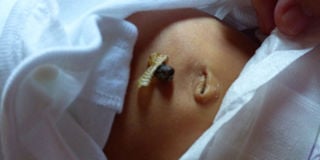Keep your baby’s umbilical cord free from infections

The umbilical cord of a new born baby is prone to several infections. Therefore, care should be taken when cleaning it.
What you need to know:
The umbilical cord is a sensitive part of a baby’s body. But not many parents know how to take good care of it and keep it free from infections.
Did you know that poor hygiene can affect a newborn baby’s umbilical cord? An umbilical cord is a tube between the growing embryo and the placenta. Genetically, it is part of the foetus, and acts as a canal through which a baby feeds while it is still in the womb.
As soon as a baby is born, the health worker who assists the mother at delivery cuts the umbilical cord to a length of between four and five centimetres.
It is immediately tied with a cord ligature to stop bleeding. Since the baby’s heart and blood vessels are directly connected to the umbilical cord, if it is left untied, the baby can bleed to death. “Most first time mothers, especially those who do not attend antenatal care have little knowledge on umbilical hygiene. This can lead to infections and subsequently death, if not managed early enough,” says Dr Nestor Mbabazi, a paediatrician, at St Jordan Clinic, on Gayaza Road.
He says it is important for women to get immunised against Tetanus Toxoid while pregnant, as this prevents their babies from catching tetanus through the umbilical cord at or after birth. After birth, the baby’s cord should only be cleaned after 24 hours.
This is because during this period, the cord is sterile, with no dirt or germs. “The umbilical cord should only be touched when it is being cleaned because if touched frequently, the risk for infection increases,” says Dr Mbabazi.
Healing time
“The umbilical cord should heal and fall off within 10 days after a child is born through a process called decay mechanism. The more careful the mother is with the cord, the fewer days the healing will take,” explains Dr Mbabazi. He says in some cases, mothers use herbs, soil, and cow dung to facilitate the quick healing of the cord, which may pose a health risk to the baby.
Dr Mbabazi says the most common type of infection to the cord is bacteria and tetanus. These infections present with various symptoms such as bleeding of the cord, discharge of pus, change in skin colour around the cord, fever and loss of appetite by the baby.
In some cases, the umbilical cord may fall off but a remnant of flesh remains. Such a condition is known as granuloma. If this happens, it can be treated by a process called cauterisation, where the remaining flesh is burnt using medication for a few days, until the cord heals. This, however, should be done by a qualified health worker.




